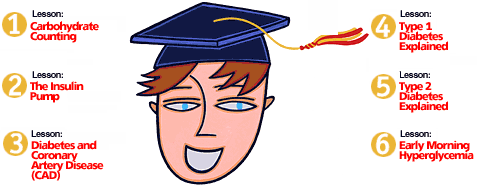


Welcome Back! You are now in Diabetes 201 Lesson #1 — Type 2 Diabetes Explained.
Get ready to learn all you've ever wanted to know (almost) about the following:
Assignment #1
 We know you want to jump right in, but before you do — give our Type 2 Diabetes Quiz the old SavvyScholar try!
We know you want to jump right in, but before you do — give our Type 2 Diabetes Quiz the old SavvyScholar try!
How was it? Are you happy with your results? Don't worry if you didn't do as well as you thought you would, because we're here to help you learn the facts that will help you manage your type 2 diabetes like a pro! You'll have a chance to take the quiz again at the end of this lesson, so for now, get comfortable and let the learning begin!
What is type 2 diabetes?
Type 2 diabetes occurs when your body doesn't make enough insulin, has difficulty using the insulin it made, or both. With inadequate insulin or difficulty using it, your cells cannot receive the glucose in your blood to burn for energy. If glucose isn't being absorbed by your cells, it will collect in your blood and lead to high blood glucose levels. In the long run, this can lead to diseases of the eyes, kidneys, nerves or heart.
A good analogy to explain how insulin works is the way a key works in a lock. In this case, the "lock" is your cell, the "key" is insulin which lets the glucose circulating in your blood into your cells.
What are the signs and symptoms of type 2 diabetes?
Type 2 diabetes is fairly common in the United States. It is estimated that 8 to 10 million people have the disease. The following symptoms should be taken as warning signs that you could have or develop type 2 diabetes:
Fatigue for no apparent reason: Even though there is insulin in your system, your body isn't using it effectively to bring glucose into your cells as fuel to burn for energy. This situation leads to energy-deprivation and a sense of fatigue.
Frequent urination and thirst: Your body will begin to release glucose that cannot be processed by your kidneys in your urine. You will start to urinate with more frequency, which causes dehydration and increased thirst.
Blurred vision: As the level of glucose in your blood increases and decreases, the lenses of your eyes swell and shrink. Your vision can blur because your eye is unable to make the rapid adjustment to your changing lens sizes.
Slow healing of skin and gums; and urinary infections: When your blood glucose is high, your white blood cells — which aid healing and guard the body from infections- do not function properly. Since the agents that can cause infection tend to do very well in a high-glucose environment, your body is particularly vulnerable to infections.
Genital itching: A high-glucose environment supports yeast growth. So, diabetes can bring about uncomfortable and persistent yeast infections.
Numbness in legs or feet: A common long-term complication of diabetes is neuropathy. Although the exact cause of this disorder of the nervous system is unknown, high blood glucose levels will contribute to it's negative effects. Neuropathy can lead to numbness in the legs or feet, which can result in foot infections, ulcerations, fractures or amputation.
Heart disease: Heart disease occurs in people with type 2 diabetes more frequently than in people without diabetes. Heart disease can start to develop before you are even diagnosed with type 2 diabetes.
Copyright © 1999-2024 savvyHEALTH.com. All rights reserved.
http://www.savvyHEALTH.com/
All contents copyright © 1999-2024 savvyHEALTH, Inc. All rights reserved.
This internet site provides information of a general nature and is
designed for educational purposes only. If you have any concerns about
your own health, you should always consult
with a physician or other healthcare professional. Please review the Terms of Use before using this site. Your use of the site indicates your agreement to be bound by the Terms of Use.